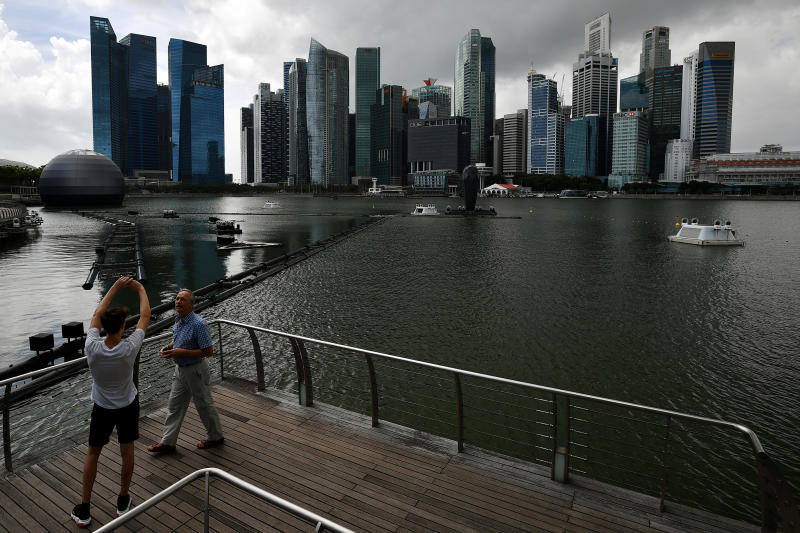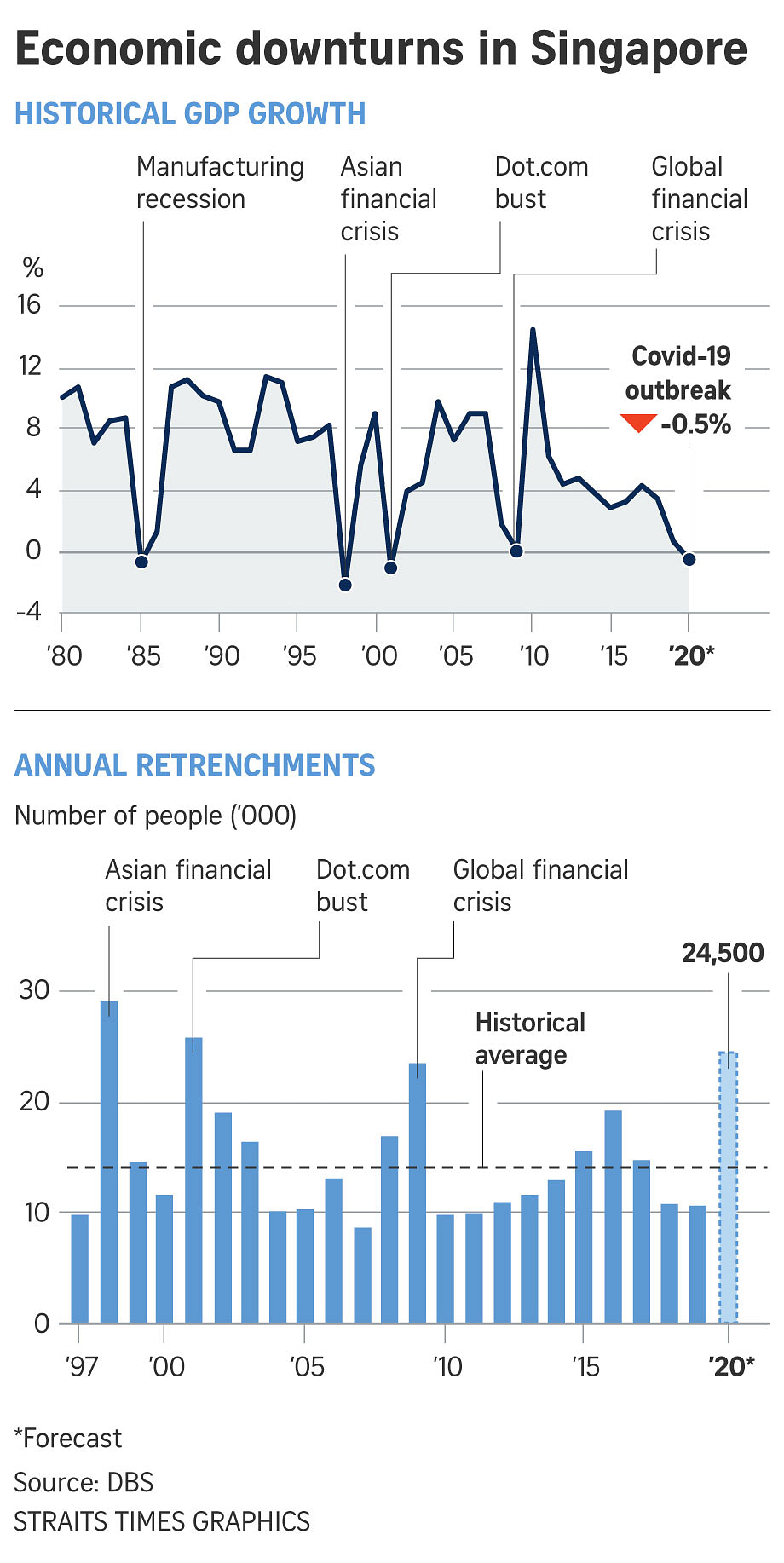DBS says Singapore recession 'inevitable'; expects 2nd stimulus package of $14-16 billion
Sign up now: Get ST's newsletters delivered to your inbox

Singapore's downturn this year is expected be a lot deeper than that during the severe acute respiratory syndrome outbreak in 2003, and more painful than the Global Financial Crisis in 2009.
ST PHOTO: LIM YAOHUI
Follow topic:
SINGAPORE - A recession in Singapore "appears inevitable", said DBS Bank as it now sees the economy shrinking by 0.5 per cent this year, instead of the 0.9 per cent growth it forecast last month.
This downgraded forecast still comes with significant downside risks should the coronavirus outbreak worsen further, DBS economist Irvin Seah said in a research note on Thursday (March 19).
He also expects total retrenchments for the year to reach about 24,500, slightly above the 23,430 in 2009 during the Global Financial Crisis.
"Considering the chaotic situation in many parts of the world and the economic costs of those restrictive measures on trade, investment, consumption and travel, this is evolving into a 'self-induced' global recession. Being a small and open economy, Singapore will not be spared," he said.
Mr Seah said a second stimulus package of up to $14 billion to $16 billion could be rolled out, funded by the remaining Budget surplus for this term of Government of about $7.7 billion and an additional $6 billion to $8 billion from the reserves.
A $4 billion Stabilisation and Support Package was announced during the Budget statement last month.
He also expects the Monetary Authority of Singapore to take a more aggressive monetary response amid falling inflation and the significant downside risk to growth.
"Specifically, we expect MAS to end the modest and gradual appreciation path of the SGD NEER (nominal effective exchange rate) policy band, and introduce a downward re-centring of the band by up to 2 per cent. In fact, an announcement before the next scheduled policy meeting around mid-April should not come as a surprise, given the urgency of the matter," he said.
Mr Seah said he expects year-on-year contractions of up to 2 percentage points for the first two quarters of the year - which would be a technical recession - and a contraction in the third quarter before an improvement at the end of the year.

He noted that this comes after the bank revised Singapore's gross domestic product growth forecast down to 0.9 per cent on Feb 7. But back then, the Covid-19 outbreak was still largely contained within China, with only pockets of infection elsewhere.
The situation has deteriorated sharply since then, with the number of infections in other parts of the world multiplying by more than 400 times, he said.
Also, travel restrictions imposed by Singapore have been broadened beyond China to cover markets accounting for about 69 per cent of Singapore's total tourist arrivals last year, he said.
These include South Korea, Britain, Japan, France and Asean countries.
As such, the services sector - particular tourism-related industries such as hotels and restaurants, aviation, point-to-point transport services, retail and entertainments services will be severely impacted.
A sharp contraction in global demand would also put a dent on the near-term prospects for Singapore's exports and the manufacturing sector, said Mr Seah, adding that global economic activity will slow significantly, as governments around the world have introduced city- and country-wide lockdowns and border closures, and companies have put in place business continuity plans.
He said that Singapore's downturn this year will be a lot deeper than that during the severe acute respiratory syndrome outbreak in 2003, and more painful than the Global Financial Crisis in 2009.
In these two downturns, Singapore still managed to post GDP growth of 4.5 per cent and 0.1 per cent respectively, he said.
He noted that the previous occasions when Singapore saw full year contractions were during the Dot.com Bust in 2001 (-1.1 per cent), the Asian Financial Crisis in 1999 (-2.2 per cent) and the manufacturing recession in 1985 (-0.6 per cent).
For the second government support package, Mr Seah proposed the following measures:
• Broaden the temporary bridging loan scheme to include all industries;
• Increase the quantum of the temporary bridging loan scheme to up to $2 million, up from $1 million;
• Increase the quantum of the working capital loan scheme to up to $1 million, up from $600,000;
• Raise wage subsidy under the Jobs Support Scheme to 12 per cent for all Singaporean workers, up from 8 per cent, with the grant covering six months instead of three;
• Disburse a one-off cash grant to micro and small enterprises immediately; and,
• Waive for one month the foreign worker levy for workers affected by measures introduced to counter the spread of Covid-19.
He also hopes to see more help for workers at risk of losing their jobs, such as deferment of personal income tax payments for all retrenched workers, a one-off retrenchment benefit for those displaced, and tax deductions for profitable companies to hire retrenched workers.
Other economists are still expecting the economy to grow over the year, for now.
OCBC Bank chief economist Selena Ling said the bank's latest forecast for Singapore's full year GDP growth is 0.3 per cent.
She added that this will be reassessed based on GDP growth data for the first quarter of this year, which will be released next month, the upcoming second fiscal stimulus package, MAS' expected monetary policy easing, and whether Malaysia will extend its Movement Control Order beyond March 31.
United Overseas Bank's growth forecast for this year is 0.5 per cent, though there are further downside risks, said the bank's economist Barnabas Gan.
He said that the estimates also assume a potential technical recession in the first half of the year.
"Accounting for the direct negative effects on Singapore's tourism industry as well as secondary effects on Asia's supply chain and external environment, we perceive Singapore's output gap to stay negative for the whole of 2020," he said, meaning that the Republic's economy is expected to perform below its potential.

